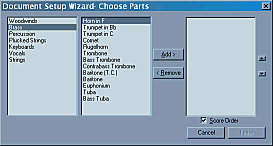
 |
![]() These
pages will help you to use PrintMusic! 2000 in a number of composing activities.
No prior knowledge of musical notation is required as the activities are based
on aural perception and pattern recognition. Those pupils who have musical experience
will also gain from these examples by composing for a purpose.
These
pages will help you to use PrintMusic! 2000 in a number of composing activities.
No prior knowledge of musical notation is required as the activities are based
on aural perception and pattern recognition. Those pupils who have musical experience
will also gain from these examples by composing for a purpose.
If you have followed the notes on using Notate (available for the RiscOS platform), you will be familiar with some of these examples. However, PrintMusic has quite a number of different features, not the least of which is having to start composing music by creating the instruments for which you wish to write. So, let's start from the very beginning (a very good place to start!).
When first run, PrintMusic will take you through some steps to help you to create your score. The main points are to enter the Title and Composer's name, the size of the page (A4) and the names of the instruments you want to use.
 Most
of the standard orchestral/band instruments are available, listed by family
(Woodwind, Brass, Strings etc.). A stave will be created for each instrument
you Select and then Add>; note that two staves will be created
for those instruments which normally require them, for instance Piano and other
keyboards and Harp. The score will arrange the staves in standard orchestral
score order. Should you want instruments in a different order, untick the Score
Order box and use the up/down arrows to change the order of the instruments.
Selecting Finish will display an A4 page with your chosen instruments. You do
not have to set up any sounds to go with the staves as PrintMusic assigns the
correct sound to each of your chosen instruments (although you can change the
sounds and stave names should you want to).
Most
of the standard orchestral/band instruments are available, listed by family
(Woodwind, Brass, Strings etc.). A stave will be created for each instrument
you Select and then Add>; note that two staves will be created
for those instruments which normally require them, for instance Piano and other
keyboards and Harp. The score will arrange the staves in standard orchestral
score order. Should you want instruments in a different order, untick the Score
Order box and use the up/down arrows to change the order of the instruments.
Selecting Finish will display an A4 page with your chosen instruments. You do
not have to set up any sounds to go with the staves as PrintMusic assigns the
correct sound to each of your chosen instruments (although you can change the
sounds and stave names should you want to).
For the first few activities, choose an instrument which uses a single stave in the treble clef, i.e. a high sounding instrument such as a flute, oboe, violin, soprano or alto.
| Quick Links: |